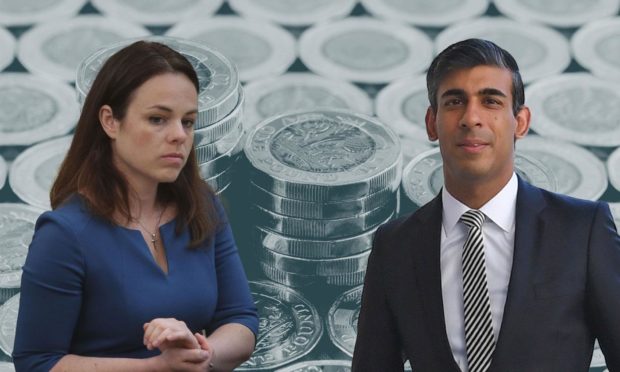The country’s annual balance sheet has revealed a 22.4% gap between revenue and spending after a brutal year for the economy.
The yearly snapshot reflects a deficit of £36.3 billion in Scotland.
For the UK as a whole, there was a deficit of 14.2%.
Knows as “Gers” figures, the Government expenditure and revenue estimates for 2020-21 also reveal the impact of North Sea oil and gas on Scotland’s finances.
The country’s geographic share of North Sea revenue fell from £800 million to £500 million compared with the previous year.
The Scottish Government highlighted record public spending of £99.2 billion, which is up 21%. It includes huge investment in the health service.
Revenue fell from £66.2 billion to £62.8 billion, including a drop in North Sea receipts of 35%.
“The pandemic has not only changed people’s lives but it has fundamentally shifted our fiscal landscape.” – Finance secretary Kate Forbes
Scotland’s deficit rose by 13.6 percentage points to the new high.
Kate Forbes, the Scottish finance and economy secretary, said: “These statistics clearly highlight the significant economic impact of the pandemic. Scotland’s economy contracted by about 10% last year, which is in line with the performance of the UK economy.
“The pandemic has not only changed people’s lives but it has fundamentally shifted our fiscal landscape, with countries and markets around the world reassessing what represents a viable deficit.”
Cash and the constitution
The annual figures were first published in 1992 under John Major when he was prime minister.
The statistics were set up to estimate what Scotland brings in and what it spends.
Conservatives thought it would show how much the UK Treasury has to play in Scotland’s financial health.
Ever since, it has become an annual political grudge match for both sides of the independence debate.
Reacting to the latest figures, Scottish Conservative covid recovery spokesman Murdo Fraser said: “These new figures demonstrate the strength and security that we gain as part of the United Kingdom.
“In times of crisis, when a pandemic hits, Scottish jobs and public services are safer because we act together.”
Ms Forbes said the figures show how 40 per cent of spending and 70 per cent of revenue income is reserved to the UK Government, overseen by Chancellor Rishi Sunak.
“The pandemic has clearly demonstrated the need for fiscal reform and that the Scottish Government’s financial powers are insufficient to deal with the new economic reality,” Ms Forbes said.
